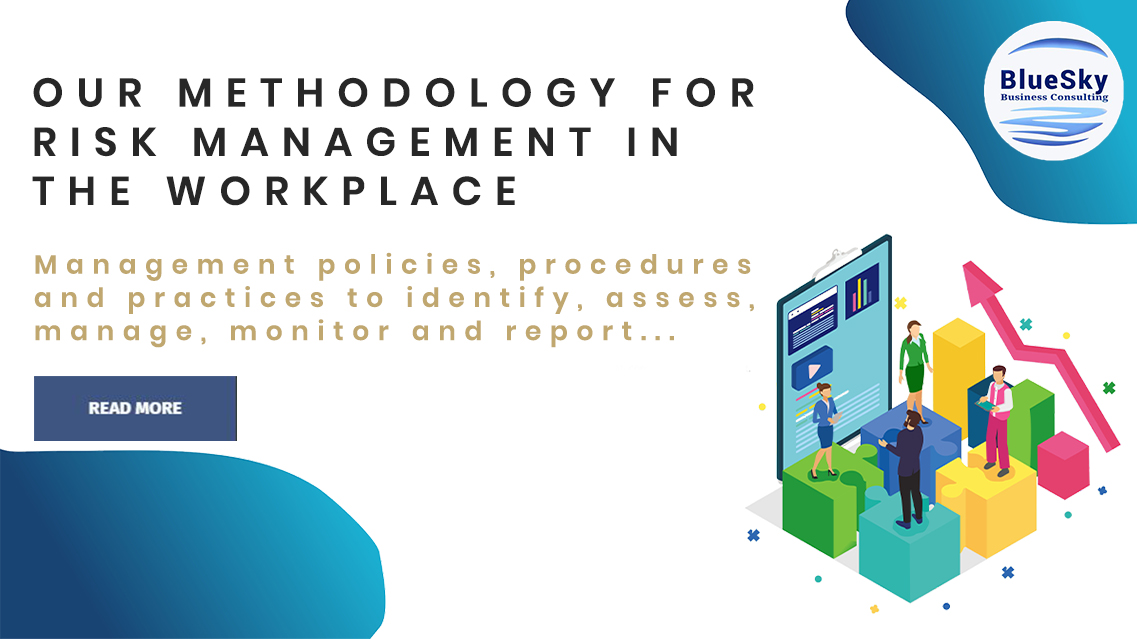
Our Methodology For Risk Management In The Workplace
BlueSky Business Consulting has been trained via the University of Queensland, Australia to use risk management in the running of your business. The methodology used for identifying and assessing risk used by BlueSky Business Consulting is based on the international risk management standard, ‘ISO 31000.’
The definition of risk:
- Risk is the effect of uncertainty (positive or negative) on objectives;
- An effect is a deviation from the expected – positive and/or negative;
- Objectives can have different aspects such as financial, health and safety, reputation etc;
- Risk is characterized by reference to potential events, consequences, or a combination of these and how they can affect the achievement of objectives;
- Risk is typically expressed as a combination of consequences or a change in circumstances and the associated likelihood (probability) of the occurrence.

Risk Management Process is the systematic application of management policies, procedures and practices to identify, assess, manage, monitor and report risk.
It is accompanied by the following attributes:
- The process explicitly addresses uncertainty and does not seek to eliminate all risk but rather to ensure an understanding of the risk and the management interventions required;
- The process is owned by management; A mature process will ensure that risk management is integrated into key business processes; strategic planning, business planning, capital projects, investment/ disposal opportunities etc.;
- Risk management is based on the best available information and should facilitate improvement and enhancement to results;
- Risk management is an ongoing process and needs to be part of the individual performance criteria of all managers
- Effective risk management should increase the likelihood of achieving objectives;
- Strengthens flexibility by having a range of options for changing circumstances to ensure that promised (committed) results are achieved.
Black Swans:
- The idea of the Black Swan comes from the fact that prior to the discovery of Australia, it was assumed by the medieval Europeans that all swans were white, because no European at the time had seen a black swan, although these did exist.
- The sight of one black swan in Australia by the European explorers invalidated millennia of belief that all swans were white.
- In the context of risk, a black swan is a metaphor referring to any event that is rare, has an extreme impact, is unexplainable and predictable when applying hindsight.
- Black Swans occur when there is a disjoint between what we know and what we think we know.
- This is fueled by facets of our human psychology that make us overconfident in our future.
- Despite the fact that we cannot forecast the future accurately in a world of black swans, if we keep our minds and eyes open, we should be able to identify the generators of black swans and learn to mitigate their impact.

- One of the key governance requirements emerging from the 21st century is that of Companies/Municipalities taking responsibility for risk management practices within their organizations.
- Empirical evidence supports the value of having good risk management systems that enable management to demonstrate diligence when identifying, assessing and mitigating risk and ensuring that organization’s are more favourably placed to respond to volatile conditions as well as leverage opportunities.
- To set the minimum standards required by the City of Mount Pearl with respect to the implementation of the risk management strategy and related risk management practices.
- It should also be noted that while policies and procedures are vitally important to ensure a disciplined approach to risk management, sound judgment and experience is integral to effective risk management implementation.
- The objective of the risk management procedures aims to build a culture of taking ‚considered risks”.
- The risk management strategy needs to be fully defined in a Risk Management Strategy document and is accompanied by a detailed execution plan.
- The objectives of implementing the risk management strategy includes the following:
- An improved understanding of the risks within the business that threaten the ability of management to achieve their objectives;
- An understanding of the effectiveness of management’s response to those risks;
- Integration of risk management into business processes designed to improve pro-active management and flexibility/robustness;
- Consistent and improved quality of risk assessments and deliverables;
- Standardization of approaches to effective risk management by building a comprehensive set of tools;
- Improving the organization’s flexibility in responding to changing circumstances without impacting business objectives;
- Reducing unacceptable performance variability;
- Building the confidence of the community and stakeholder’s;
- Increased knowledge sharing within the municipality both in terms of sharing risk knowledge and mitigation/ optimization techniques;
- Improved link to assurance frameworks and processes



